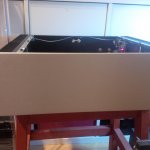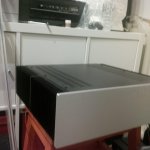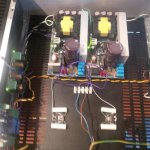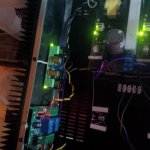First One v 1.2
I know I am a bit late, but I just finished my First One v 1.2.
Anything I can do to upgrade to a more recent version? probably just Andrej can help me do that.
Anyway, here I attach some photos from my build.
I used some power supplies from eBay (eBay article number 121478378676), without regulation, and they are doing a wonderful job. With 230V input they deliver 2x55V DC, 1200W each. They have a relay that shorts a slow turn on power resistor after charging of the main reservoir cap. I have increased the value of the cap from 2x220uF to 1000uF/450V.
The sound is excellent, with even more bass than my XVSSA (which is still a reference to me). I wonder what can be improved over this 😀 The destination loudspeakers will be Monitor Audio Bronze BX5.
I know I am a bit late, but I just finished my First One v 1.2.
Anything I can do to upgrade to a more recent version? probably just Andrej can help me do that.
Anyway, here I attach some photos from my build.
I used some power supplies from eBay (eBay article number 121478378676), without regulation, and they are doing a wonderful job. With 230V input they deliver 2x55V DC, 1200W each. They have a relay that shorts a slow turn on power resistor after charging of the main reservoir cap. I have increased the value of the cap from 2x220uF to 1000uF/450V.
The sound is excellent, with even more bass than my XVSSA (which is still a reference to me). I wonder what can be improved over this 😀 The destination loudspeakers will be Monitor Audio Bronze BX5.
Attachments
The best result you'll get as dual mono with two SMPS1200A400, one per channel.First off, I know most people are using two Hypex SMPS600 for the PSU. I know earlier in this thread it was discussed that one Hypex SMPS1200A400 could be used for a stereo pair of amp modules with the side effect of the F1 modules creating a little more heat. Was there ever a sound comparison made between the two?
Also, if I get the Standard 4U Amplifier Chassis from the diyAudio store, how many v.4 modules can I fit in there? (I am assuming at least 4.)
Thanks for your tolerance and patience if these questions are repeats. 😱
Allen
I suppose you could install 4 FO modules, just be aware that one FO module sinks 280 mA at idle, so the idle power dissipation has to be calculated and taken into account at specific chassis thermal capability.
Yes, the new First One v1.4 version will be offered as: 80 W/8 Ohm - S (Small: 50 x 60 mm), 160 W/8 Ohm - M (Medium: 50 x 100 mm) and 240 W/8 Ohm - L (Large: 50 x 160 mm). We'll start with First One v1.4 M, S and L will follow later.Maybe it is the long hours at work, or I missed it.
Not only are there versions of F1, now we have different models?!?
Okay, so what is with the "S", "M" and "L"?
Small, Medium, Large?
Sorry if this has been already discussed, this is the first day I have had off in 3 weeks, so I am trying to get as much out of it as I can! 😉
Andrej,
Do you accept orders now?
Can't wait to have the V 1.4 modules... 😉
Mark
Kindly ask both of you to follow this thread. The official launch will be announced as soon as First One v1.4 modules will arrive from production, which is expected to be in a week. As I was informed on Friday 200 PCB-s already sent to assembly so I expect the production's result soon as well.Anything I can do to upgrade to a more recent version? probably just Andrej can help me do that.
I know your's XVSSA is very clever balanced input VSSA variant, I can imagine that you like it a lot. Still, new First One v1.4 has some attributes impossible to achieve with simple topology as VSSA and previous First One versions are. Surprise was not only reserved to me but to anyone who have heard it up to now, so expect the unexpected.The sound is excellent, with even more bass than my XVSSA (which is still a reference to me). I wonder what can be improved over this 😀 The destination loudspeakers will be Monitor Audio Bronze BX5.
L.C.

Thanks, Lazy, this must be Exciting for You!
Awesome! Medium for the Mains and Large for the subs.
W😀W, now that is some current! Does this apply to all the FO v.4 versions of modules: Small, Medium, and Large?
Again, does 280 mA idle apply to all the FO versions of Small, Medium and Large?
...I will look into the capacity of the diyAudio chassis more and get back to You, as I may need help figuring this out. I am sure there are others considering the 4U and 5U chassis for their FO v.4 projects.
Exciting!
Yes, the new First One v1.4 version will be offered as: 80 W/8 Ohm - S (Small: 50 x 60 mm), 160 W/8 Ohm - M (Medium: 50 x 100 mm) and 240 W/8 Ohm - L (Large: 50 x 160 mm). We'll start with First One v1.4 M, S and L will follow later.
Awesome! Medium for the Mains and Large for the subs.
The best result you'll get as dual mono with two SMPS1200A400, one per channel.
W😀W, now that is some current! Does this apply to all the FO v.4 versions of modules: Small, Medium, and Large?
I suppose you could install 4 FO modules, just be aware that one FO module sinks 280 mA at idle, so the idle power dissipation has to be calculated and taken into account at specific chassis thermal capability.
Again, does 280 mA idle apply to all the FO versions of Small, Medium and Large?
...I will look into the capacity of the diyAudio chassis more and get back to You, as I may need help figuring this out. I am sure there are others considering the 4U and 5U chassis for their FO v.4 projects.
Exciting!
I know I am a bit late, but I just finished my First One v 1.2.
Which casing did you use?
Just for your information if anyone's interested First One v1.4 silver. 😉
Also some other stuff available. 🙂
Also some other stuff available. 🙂
Medium and Large
Hi LC,
The Large version will have identical sq and character with the Medium ?
Hi LC,
The Large version will have identical sq and character with the Medium ?
LC,
You going to put up some type of order form for placing orders once you can start to full-fill them?
Rick
You going to put up some type of order form for placing orders once you can start to full-fill them?
Rick
Since I received preproduction FO 1.4 last month I had a feeling that something was not optimal. I could hear more but there was also something wrong in the music. I could not pinpoint the problem, but one of the suspects was also my source, Naim superuniti, used as a streamer preamp.
So this saturday we did some source comparison. I fired up an old cd player sony cdx3000. I tried the spdif and toslink and noticed that on the same material my Naim was better than through build in streamer.
Next was Cambridge audio 851n. Even though it was better than Lazy Cats Benchmark dac2 it was worse than my Naim. Last one was lazy cats anagram dac (made for OEM in swiss) with modified stepped switch volume adjustment and improved output stages. This one has separate streamer to spdif module and master clock with power supply.
All the previous ones sounded a bit cold in presentation, but Anagram dac really stepped up. We easily forgot that we were not listening to recording. Music really became warm and alive. I was not prepared for that. I never heard music play in such a good way.
All I can say is that FO1.4 revealed all the subtle differences in an easy to hear way. As the source changed so did the presentation of the music.
I guess new source is needed from my part.
So this saturday we did some source comparison. I fired up an old cd player sony cdx3000. I tried the spdif and toslink and noticed that on the same material my Naim was better than through build in streamer.
Next was Cambridge audio 851n. Even though it was better than Lazy Cats Benchmark dac2 it was worse than my Naim. Last one was lazy cats anagram dac (made for OEM in swiss) with modified stepped switch volume adjustment and improved output stages. This one has separate streamer to spdif module and master clock with power supply.
All the previous ones sounded a bit cold in presentation, but Anagram dac really stepped up. We easily forgot that we were not listening to recording. Music really became warm and alive. I was not prepared for that. I never heard music play in such a good way.
All I can say is that FO1.4 revealed all the subtle differences in an easy to hear way. As the source changed so did the presentation of the music.
I guess new source is needed from my part.
Last edited:
Hopefully the FO 1.4 won't be picky from the source selected... In your case, it could have been an impedance mismatch causing all this..
Do
Do
Yes, they're sharing the same front-end.Hi LC,
The Large version will have identical sq and character with the Medium ?
At a start an e-mail, later a webshop for that purpose.LC,
You going to put up some type of order form for placing orders once you can start to full-fill them?
Rick
THT production finished this week, next week first deliveries will start locally, soon after worldwide.I'm ready to buy! My dual mono FO 1.2 want a new friend!😀
Hi DoHopefully the FO 1.4 won't be picky from the source selected... In your case, it could have been an impedance mismatch causing all this..
Do
I think what was hose4 tried to say is that with the First One v1.4 revealing different sources is a piece of cake, one can do it with ease. There's no limit, the better the source the better the sound, like with all amps, only here the differences are so obvious even an old man could tell.
L.C.

"THT production finished this week, next week first deliveries will start locally, soon after worldwide." Did I miss something, when the ordering has begun?
Did you have results from your american tests? 🙂
Did you have results from your american tests? 🙂
Hopefully the FO 1.4 won't be picky from the source selected... In your case, it could have been an impedance mismatch causing all this..
Do
All the sources are around 50 ohm on the output. FO is around 10k. So no impedance mismatch.
LC, any comments?
"THT production finished this week, next week first deliveries will start locally, soon after worldwide." Did I miss something, when the ordering has begun?
Did you have results from your american tests? 🙂
No, you didn't miss anything, ordering will begin when the modules will be calibrated, tested and packed. Last week SMD was finished, this week selective soldering unit was programmed, so I expect next week all THT parts will be soldered and then we can start with calibrations and packaging. You'll see pics here first then the race will start.
All the sources are around 50 ohm on the output. FO is around 10k. So no impedance mismatch.
LC, any comments?
Agree, all sources have low analog output impedance ranging from 22 Ohm (Naim SuperUniti), 24 Ohm (Anagram DAC), 30 Ohm (Cambridge Azur 851N), all intended to act as preamplifiers to drive power amps directly. The differences are mainly result of using specific DAC chips, I/V op amps and pre processing in DSP. Sound differentiating with First One is easy, what you hear is what you get, meaning first 15 min reveals it all, no need to live 6 months and share an apartment with DUT (device under test). In this respect Anagram took off to an orbit compared to the other two and I must say it was quite an impressive view..
- Home
- Vendor's Bazaar
- First One - mosFET amplifier module



